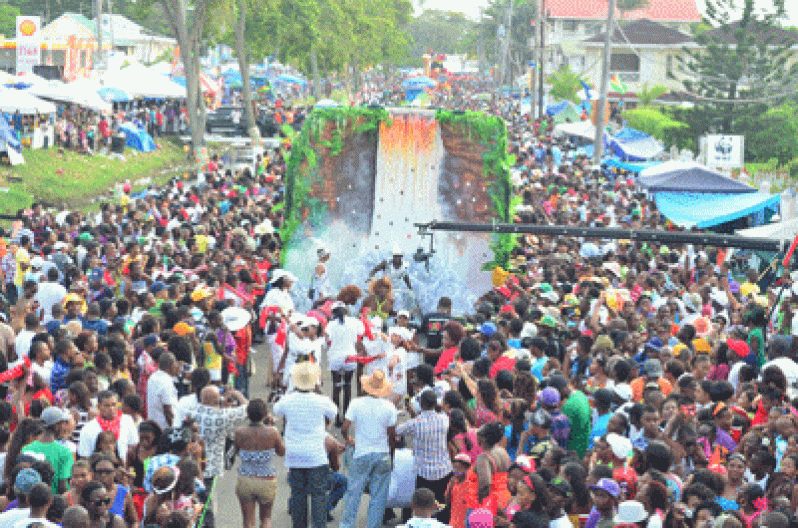ON FRIDAY, August 29, 1969, a resolution was passed in Parliament that Guyana would become a Cooperative Republic on February 23, 1970. According to the President at the time, Mr Forbes Burnham, this action “… marks symbolically Guyana’s determination to depend on Guyana for Guyanese progress in the world.” In order to mark the achievement of Republican status, the Government introduced the national holiday, which is called Mashramani.
A SECULAR HOLIDAY
Mashramani is a secular holiday which is celebrated to mark the successful results in the public and private sectors after months of hard work. Hence, Mashramani is different from Carnival in Trinidad, in that the real purpose of this occasion is to showcase the achievements of the various sectors of Guyanese society.
That is the reason why there are children’s costume and dramatic poetry competitions to depict various aspects of our Guyanese culture. There are also float parades, which help Guyanese to appreciate what progress has been made in eco-tourism, agriculture, mining, housing, etc. But that aspect of Mashramani would be a failure if Guyanese and their visitors did not come out and line the parapets and streets to view the floats in which the Government, business places, and private organisations invest lots of time, talent and money.
Mr Allan Fiedtkou of Linden contributed the name Mashramani to the Republican celebration, and in 1970, Mashramani was first held in the Linden area. However, since 1971, it has become a Guyana-wide celebration, in which all ten regions are expected to participate.
The underlying two themes of Mashramani, in addition to the current theme are:
* Self-help or Community Development and
* Making the small man a real man
We have always been taught that Mashramani is derived from the Arawak word, ‘Mashirimehi’, or ‘Masromanie’, which means ‘Celebration after a good harvest’. In other words, one expects that after an entire community pools its resources, time and effort to complete a project in the community, that there will be celebration when the work is completed.
FIRST MAJOR COOPERATIVE EFFORTS
The first major cooperative efforts which have been documented in Guyanese history have been the purchase of the two villages, namely Victoria and Buxton.
In 1839, eighty-three slaves pooled their savings and purchased the abandoned cotton plantation, Plantation Northbrook. They subsequently renamed it Victoria after the reigning Monarch of the British Empire. In April, 1840, one hundred and twenty-eight ex-slaves from Plantations Annandale, Non Pariel and Lusignan purchased Plantation Orange Nassau. They renamed the plantation Buxton, or, as some said, Boxon. It is an established fact that it was not named after Thomas Foxwell Buxton.
One of the major setbacks which these early villages faced was that after they had invested all their savings in purchasing their property, they did not have money left to take care of the infrastructure, that is, the sea defence, roads, drainage, etc. They could not obtain loans easily, because the planters were opposed to them living independently of the sugar plantations. The hostility of the planters posed a severe threat to the survival of many of these villages.
EASY LOAN ACCESS
In 1970, the Government recognised that it was not only important for communities to contribute to their development (by building through cooperative efforts, their own schools, hospitals, roads, sea and river defences) but to also obtain loans easily , irrespective of class, colour or ethnicity. Hence, the Guyana National Cooperative Bank (GNCB) was established on February 23, 1970.
In the Linden area, where the first Mashramani celebrations were held in 1970, the workers of DEMBA (LINMINE) contributed $1.00 a week towards the construction of a hospital at Wismar.
Today, there are more indigenous or local banks and micro-enterprise organisations in Guyana, from which Guyanese can access loans for developing their communities or establishing businesses. It is therefore not strange if these commercial banks or organisations, like IPED and GO-INVEST, have floats during Mashramani to show Guyanese how they have helped hardworking communities as well as groups of small businessmen to achieve their objectives.
There are also organisations like Habitat for Humanity, SIMAP, Youth Challenge and the Commonwealth Youth Programme which help self-help groups to house and support themselves with access to the required financial assistance.
The second theme of Mashramani is `The Small Man will become a Real Man’. In other words, during Mashramani, we recognise those small men and women who, by dint of hard work, sacrifice, and cooperative team effort, have become real or important persons in the community.
The first person who was recognised as a hero of small men who rose to prominence in Guyana, was the slave, Cuffy. He led the 1763 slave rebellion, and for 18 months was the leader of his own Government until he was betrayed.
NATIONAL AWARDEES
Years ago, the Government made a point of announcing the National Awardees on the eve of the Mashramani celebrations.
The word Mashramani is itself a tacit admission of the recognition of the Amerindian presence and contribution to Guyanese society.
Now that we know the purpose of Mashramani, we should not, as young people, allow the festival to be consigned to the dust heap, or replaced by some other holiday honouring some personage in our society. We should ensure that we combine our skills and energies to ensure that the next generation will be able to take that one day of rest to celebrate ours and their achievements in Guyana. (First published in the February 27, 2000 of the Guyana Chronicle)
(By Hazel Woolford)




.jpg)









